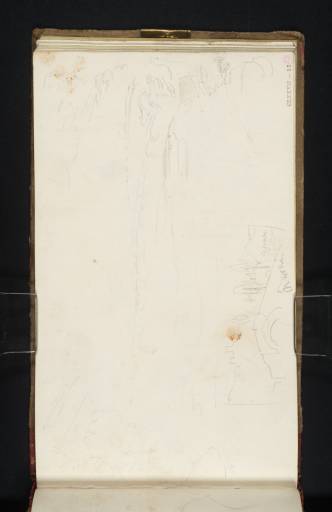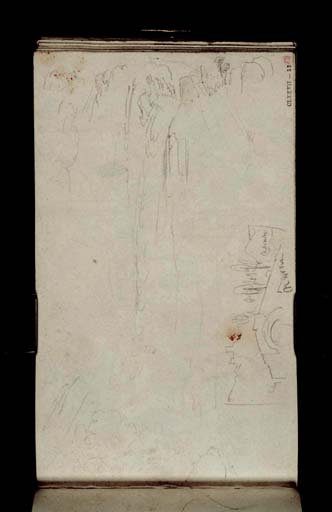Joseph Mallord William Turner Part of the Cascata delle Marmore; and a Distant View of Narni 1819
Image 1 of 2
Joseph Mallord William Turner,
Part of the Cascata delle Marmore; and a Distant View of Narni
1819
Joseph Mallord William Turner 1775–1851
Folio 53 Recto:
Part of the Cascata delle Marmore; and a Distant View of Narni 1819
D14756
Turner Bequest CLXXVII 53
Turner Bequest CLXXVII 53
Pencil on white wove paper, 186 x 110 mm
Inscribed by the artist in pencil ‘Narni’ twice within smaller sketch along right-hand edge
Inscribed by John Ruskin in red ink ‘53’ top right, ascending right-hand edge
Stamped in black ‘CLXXVII 53’ top right, ascending right-hand edge
Inscribed by the artist in pencil ‘Narni’ twice within smaller sketch along right-hand edge
Inscribed by John Ruskin in red ink ‘53’ top right, ascending right-hand edge
Stamped in black ‘CLXXVII 53’ top right, ascending right-hand edge
Accepted by the nation as part of the Turner Bequest 1856
References
1909
A.J. Finberg, A Complete Inventory of the Drawings of the Turner Bequest, London 1909, vol.I, p.522, as ‘Falls, and a view of “Narni” ’.
1984
Cecilia Powell, ‘Turner on Classic Ground: His Visits to Central and Southern Italy and Related Paintings and Drawings’, unpublished Ph.D thesis, Courtauld Institute of Art, University of London 1984, pp. 101, 469 note 143.
1987
Cecilia Powell, Turner in the South: Rome, Naples, Florence, New Haven and London 1987, p.34.
2008
James Hamilton, Nicola Moorby, Christopher Baker and others, Turner e l’Italia, exhibition catalogue, Palazzo dei Diamanti, Ferrara 2008, pp.44, 90 note 29.
2009
James Hamilton, Nicola Moorby, Christopher Baker and others, Turner & Italy, exhibition catalogue, National Galleries of Scotland, Edinburgh 2009, pp.42, 150–1 note 29.
At Terni, Turner made a short detour from his route in order to visit the nearby Falls, one of the main highlights of the journey between Ancona and Rome. An entirely man-made phenomenon, this impressive waterfall was created by the ancient Romans who diverted the course of the River Velino so that the waters descended into the Nera valley below in three successive stages. The whiteness of the resulting spray led to the popular appellation the ‘Cascata’ or ‘Caduta delle Marmore’ (Falls of Marble). During the eighteenth and nineteenth centuries the waterfall represented one of the most popular tourist destinations in Italy outside of Rome. 1 For a full discussion see folio 55 verso (D14760).
This sketch depicts the first and longest stage of the waterfall where the waters cascade over the edge of the summit in a sheer, straight drop. Turner’s viewpoint was the Belvedere Superiore, a small stone hut built by Pope Pius VI to shelter tourists who wished to witness the exciting spectacle of the falls whilst protected from the elements. This structure, which still exists today, stands on a rocky outcrop near the top of the summit, almost level with the brink. It can be seen in another sketch, see folio 51 (D14752). Turner has used the sketchbook vertically in order to capture an impression of the dramatic height of the spectacle and he has indicated the force and spray of the rushing water sparingly with bold hatched lines and large areas of blank white paper.
A further sketch can be found on folio 52 (D14754).
A further sketch can be found on folio 52 (D14754).
Turner has also used this page horizontally to draw a small separate landscape sketch of a bridge which he has labelled ‘Narni’, the next town on the Via Flaminia south of Terni. The square-towered building visible in the background is the Rocca, the fourteenth-century castle built by Cardinal Albornoz.
Nicola Moorby
November 2008
Today the waters are diverted for use in a hydroelectric power plant and so the falls are only ‘turned on’ intermittently for the benefit of tourists, see http://www.marmore.it/document.php?id=14 , accessed November 2008.
How to cite
Nicola Moorby, ‘Part of the Cascata delle Marmore; and a Distant View of Narni 1819 by Joseph Mallord William Turner’, catalogue entry, November 2008, in David Blayney Brown (ed.), J.M.W. Turner: Sketchbooks, Drawings and Watercolours, Tate Research Publication, December 2012, https://www


